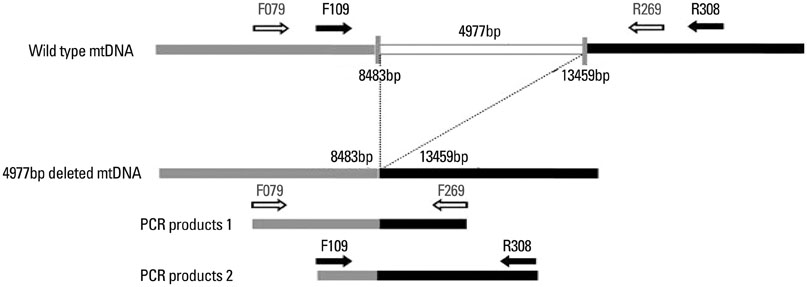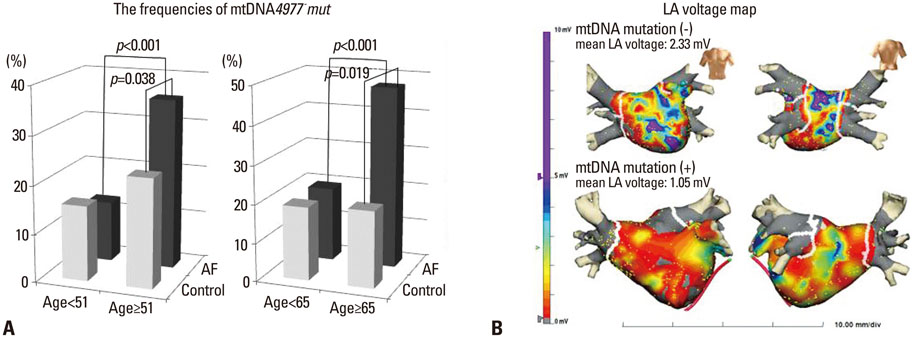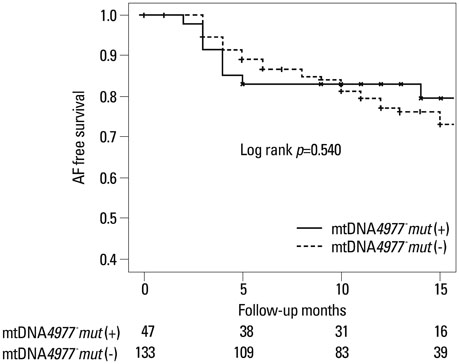Yonsei Med J.
2015 Jan;56(1):53-61. 10.3349/ymj.2015.56.1.53.
Mitochondrial DNA 4977bp Deletion Mutation in Peripheral Blood Reflects Atrial Remodeling in Patients with Non-Valvular Atrial Fibrillation
- Affiliations
-
- 1Department of Internal Medicine, Yonsei Univerisity College of Medicine, Seoul, Korea. ygko@yuhs.ac
- 2Department of Forensic Medicine, Yonsei Univerisity College of Medicine, Seoul, Korea. kjshin@yuhs.ac
- KMID: 2352789
- DOI: http://doi.org/10.3349/ymj.2015.56.1.53
Abstract
- PURPOSE
Recently, mitochondrial DNA 4977bp deletion (mtDNA4977-mut), a somatic mutation related to oxidative stress, has been shown to be associated with atrial fibrillation (AF). We hypothesized that patient age, as well as electroanatomical characteristics of fibrillating left atrial (LA), vary depending on the presence of mtDNA4977-mut in peripheral blood among patients with non-valvular AF.
MATERIALS AND METHODS
Analyzing clinical and electroanatomical characteristics, we investigated the presence of the mtDNA4977-mut in peripheral blood of 212 patients (51.1+/-13.2 years old, 83.5% male) undergoing catheter ablation for non-valvular AF, as well as 212 age-matched control subjects.
RESULTS
The overall frequency of peripheral blood mtDNA4977-mut in patients with AF and controls was not significantly different (24.5% vs. 19.3%, p=0.197). When the AF patient group was stratified according to age, mtDNA4977-mut was more common (47.4% vs. 20.0%, p=0.019) in AF patients older than 65 years than their age-matched controls. Among AF patients, those with mtDNA4977-mut were older (58.1+/-11.9 years old vs. 48.8+/-11.9 years old, p<0.001). AF patients positive for the mtDNA mutation had greater LA dimension (p=0.014), higher mitral inflow peak velocity (E)/diastolic mitral annular velocity (Em) ratio (p<0.001), as well as lower endocardial voltage (p=0.035), and slower conduction velocity (p=0.048) in the posterior LA than those without the mutation. In multivariate analysis, E/Em ratio was found to be significantly associated with the presence of mtDNA4977-mut in peripheral blood.
CONCLUSION
mtDNA4977-mut, an age-related somatic mutation detected in the peripheral blood, is associated with advanced age and electro-anatomical remodeling of the atrium in non-valvular AF.
MeSH Terms
-
Adult
Aged
Atrial Fibrillation/blood/*genetics/*physiopathology
Atrial Remodeling/*genetics
Base Pairing/*genetics
Case-Control Studies
DNA, Mitochondrial/*blood/*genetics
Female
Heart Atria/pathology/physiopathology
Humans
Kaplan-Meier Estimate
Logistic Models
Male
Middle Aged
Mutation Rate
Phenotype
Sequence Deletion/*genetics
DNA, Mitochondrial
Figure
Reference
-
1. Benjamin EJ, Wolf PA, D'Agostino RB, Silbershatz H, Kannel WB, Levy D. Impact of atrial fibrillation on the risk of death: the Framingham Heart Study. Circulation. 1998; 98:946–952.2. Arnar DO, Thorvaldsson S, Manolio TA, Thorgeirsson G, Kristjansson K, Hakonarson H, et al. Familial aggregation of atrial fibrillation in Iceland. Eur Heart J. 2006; 27:708–712.
Article3. Biagini G, Pallotti F, Carraro S, Sgarbi G, Pich MM, Lenaz G, et al. Mitochondrial DNA in platelets from aged subjects. Mech Ageing Dev. 1998; 101:269–275.
Article4. Marin-Garcia J, Goldenthal MJ, Moe GW. Mitochondrial pathology in cardiac failure. Cardiovasc Res. 2001; 49:17–26.
Article5. Ferrari R. The role of mitochondria in ischemic heart disease. J Cardiovasc Pharmacol. 1996; 28:Suppl 1. S1–S10.
Article6. Schon EA, Rizzuto R, Moraes CT, Nakase H, Zeviani M, DiMauro S. A direct repeat is a hotspot for large-scale deletion of human mitochondrial DNA. Science. 1989; 244:346–349.
Article7. Johns DR, Rutledge SL, Stine OC, Hurko O. Directly repeated sequences associated with pathogenic mitochondrial DNA deletions. Proc Natl Acad Sci U S A. 1989; 86:8059–8062.
Article8. Meissner C, von Wurmb N, Schimansky B, Oehmichen M. Estimation of age at death based on quantitation of the 4977-bp deletion of human mitochondrial DNA in skeletal muscle. Forensic Sci Int. 1999; 105:115–124.
Article9. Soong NW, Hinton DR, Cortopassi G, Arnheim N. Mosaicism for a specific somatic mitochondrial DNA mutation in adult human brain. Nat Genet. 1992; 2:318–323.
Article10. Lai LP, Tsai CC, Su MJ, Lin JL, Chen YS, Tseng YZ, et al. Atrial fibrillation is associated with accumulation of aging-related common type mitochondrial DNA deletion mutation in human atrial tissue. Chest. 2003; 123:539–544.
Article11. Lin PH, Lee SH, Su CP, Wei YH. Oxidative damage to mitochondrial DNA in atrial muscle of patients with atrial fibrillation. Free Radic Biol Med. 2003; 35:1310–1318.
Article12. Schnabel RB, Sullivan LM, Levy D, Pencina MJ, Massaro JM, D'Agostino RB Sr, et al. Development of a risk score for atrial fibrillation (Framingham Heart Study): a community-based cohort study. Lancet. 2009; 373:739–745.
Article13. Park JH, Pak HN, Kim SK, Jang JK, Choi JI, Lim HE, et al. Electrophysiologic characteristics of complex fractionated atrial electrograms in patients with atrial fibrillation. J Cardiovasc Electrophysiol. 2009; 20:266–272.
Article14. Pak HN, Oh YS, Lim HE, Kim YH, Hwang C. Comparison of voltage map-guided left atrial anterior wall ablation versus left lateral mitral isthmus ablation in patients with persistent atrial fibrillation. Heart Rhythm. 2011; 8:199–206.
Article15. Schillinger KJ, Patel VV. Atrial fibrillation in the elderly: the potential contribution of reactive oxygen species. J Geriatr Cardiol. 2012; 9:379–388.
Article16. Hattori K, Tanaka M, Sugiyama S, Obayashi T, Ito T, Satake T, et al. Age-dependent increase in deleted mitochondrial DNA in the human heart: possible contributory factor to presbycardia. Am Heart J. 1991; 121(6 Pt 1):1735–1742.
Article17. Linnane AW, Marzuki S, Ozawa T, Tanaka M. Mitochondrial DNA mutations as an important contributor to ageing and degenerative diseases. Lancet. 1989; 1:642–645.
Article18. Hou JH, Wei YH. The unusual structures of the hot-regions flanking large-scale deletions in human mitochondrial DNA. Biochem J. 1996; 318(Pt 3):1065–1070.
Article19. Fukagawa NK, Li M, Liang P, Russell JC, Sobel BE, Absher PM. Aging and high concentrations of glucose potentiate injury to mitochondrial DNA. Free Radic Biol Med. 1999; 27:1437–1443.
Article20. Wei YH, Lee HC. Oxidative stress, mitochondrial DNA mutation, and impairment of antioxidant enzymes in aging. Exp Biol Med (Maywood). 2002; 227:671–682.
Article21. Reilly SN, Jayaram R, Nahar K, Antoniades C, Verheule S, Channon KM, et al. Atrial sources of reactive oxygen species vary with the duration and substrate of atrial fibrillation: implications for the antiarrhythmic effect of statins. Circulation. 2011; 124:1107–1117.
Article22. Kim YM, Guzik TJ, Zhang YH, Zhang MH, Kattach H, Ratnatunga C, et al. A myocardial Nox2 containing NAD(P)H oxidase contributes to oxidative stress in human atrial fibrillation. Circ Res. 2005; 97:629–636.
Article23. Nishijima Y, Sridhar A, Bonilla I, Velayutham M, Khan M, Terentyeva R, et al. Tetrahydrobiopterin depletion and NOS2 uncoupling contribute to heart failure-induced alterations in atrial electrophysiology. Cardiovasc Res. 2011; 91:71–79.
Article24. Shiroshita-Takeshita A, Brundel BJ, Lavoie J, Nattel S. Prednisone prevents atrial fibrillation promotion by atrial tachycardia remodeling in dogs. Cardiovasc Res. 2006; 69:865–875.
Article25. Rudolph V, Andrié RP, Rudolph TK, Friedrichs K, Klinke A, Hirsch-Hoffmann B, et al. Myeloperoxidase acts as a profibrotic mediator of atrial fibrillation. Nat Med. 2010; 16:470–474.
Article26. Richter B, Gwechenberger M, Socas A, Zorn G, Albinni S, Marx M, et al. Markers of oxidative stress after ablation of atrial fibrillation are associated with inflammation, delivered radiofrequency energy and early recurrence of atrial fibrillation. Clin Res Cardiol. 2012; 101:217–225.
Article27. Bonilla IM, Sridhar A, Györke S, Cardounel AJ, Carnes CA. Nitric oxide synthases and atrial fibrillation. Front Physiol. 2012; 3:105.
Article28. Yoshida H, Bao L, Kefaloyianni E, Taskin E, Okorie U, Hong M, et al. AMP-activated protein kinase connects cellular energy metabolism to KATP channel function. J Mol Cell Cardiol. 2012; 52:410–418.
Article29. Sasaki N, Sato T, Marbán E, O'Rourke B. ATP consumption by uncoupled mitochondria activates sarcolemmal K(ATP) channels in cardiac myocytes. Am J Physiol Heart Circ Physiol. 2001; 280:H1882–H1888.30. Liu M, Sanyal S, Gao G, Gurung IS, Zhu X, Gaconnet G, et al. Cardiac Na+ current regulation by pyridine nucleotides. Circ Res. 2009; 105:737–745.31. Tsuboi M, Hisatome I, Morisaki T, Tanaka M, Tomikura Y, Takeda S, et al. Mitochondrial DNA deletion associated with the reduction of adenine nucleotides in human atrium and atrial fibrillation. Eur J Clin Invest. 2001; 31:489–496.
Article32. Wijffels MC, Kirchhof CJ, Dorland R, Allessie MA. Atrial fibrillation begets atrial fibrillation. A study in awake chronically instrumented goats. Circulation. 1995; 92:1954–1968.33. Tsang TS, Barnes ME, Gersh BJ, Bailey KR, Seward JB. Left atrial volume as a morphophysiologic expression of left ventricular diastolic dysfunction and relation to cardiovascular risk burden. Am J Cardiol. 2002; 90:1284–1289.
Article34. Tsang TS, Gersh BJ, Appleton CP, Tajik AJ, Barnes ME, Bailey KR, et al. Left ventricular diastolic dysfunction as a predictor of the first diagnosed nonvalvular atrial fibrillation in 840 elderly men and women. J Am Coll Cardiol. 2002; 40:1636–1644.
Article35. Pritchett AM, Mahoney DW, Jacobsen SJ, Rodeheffer RJ, Karon BL, Redfield MM. Diastolic dysfunction and left atrial volume: a population-based study. J Am Coll Cardiol. 2005; 45:87–92.36. Lee JS, Shim CY, Wi J, Joung B, Ha JW, Lee MH, et al. Left ventricular diastolic function is closely associated with mechanical function of the left atrium in patients with paroxysmal atrial fibrillation. Circ J. 2013; 77:697–704.
Article37. Kim SK, Park JH, Kim JY, Choi JI, Joung B, Lee MH, et al. High plasma concentrations of transforming growth factor-β and tissue inhibitor of metalloproteinase-1: potential non-invasive predictors for electroanatomical remodeling of atrium in patients with non-valvular atrial fibrillation. Circ J. 2011; 75:557–564.
Article38. Aviles RJ, Martin DO, Apperson-Hansen C, Houghtaling PL, Rautaharju P, Kronmal RA, et al. Inflammation as a risk factor for atrial fibrillation. Circulation. 2003; 108:3006–3010.
Article
- Full Text Links
- Actions
-
Cited
- CITED
-
- Close
- Share
- Similar articles
-
- Relation of Right Atrial Pathology to Atrial Fibrillation in Mitral Valvular Disease
- The Impact of the CHAâ‚‚DSâ‚‚-VASc Score on Recurrence of Atrial Fibrillation after a Single Catheter Ablation and Atrial Remodeling in Patients with Non-Valvular Atrial Fibrillation
- Cardioembolic Stroke in Atrial Fibrillation-Rationale for Preventive Closure of the Left Atrial Appendage
- Relation between Left Atrial Size and Atrial Fibrillation
- Pathophysiology and Diagnosis in Atrial Fibrillation




